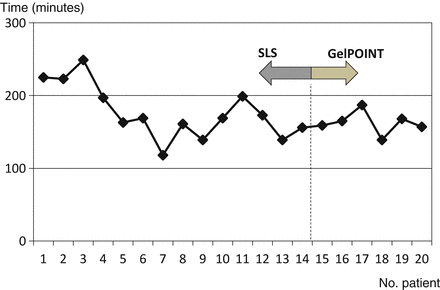Fig. 40.1
(a) SILSTM port (Covidien) and laparoscope positioning during single-port left retroperitoneal laparoscopic surgery. (b) GelPOINT (Applied Medical) and laparoscope positioning during single-port left retroperitoneal laparoscopic surgery. (c) Intraoperative view. Using a flexible laparoscopic instrument (Covidien), laparoscopic surgery was performed by the retroperitoneal technique in all cases. (a): the left renal artery. (d) The wound (3.5 cm) 1 month after surgery
The renal hilum was approached initially, and the renal artery and vein were sequentially controlled with clip-ligation (Hem-o-lok, McMedical, Tokyo, Japan). When L- and XL-type clip-ligation is necessary, the 5-mm port is temporarily changed to a 12-mm port (Fig. 40.2). For patients undergoing nephrectomy, concomitant adrenalectomy was performed in patients with an upper pole tumor or with radiographic evidence of adrenal involvement.


Fig. 40.2
Learning curve
40.3 Learning Curve
Total operative times for the 20 single-port retroperitoneal laparoscopic nephrectomies (SPRLN) are demonstrated in Fig. 40.2. Operative time gradually decreased in about the first 5 cases and remained stable in the next 15 cases.
40.4 Comparative Outcomes Between Single-Port and Standard Retroperitoneal Laparoscopic Radical Nephrectomy
Twenty patients with renal cell carcinoma entered our SPRLN, and 12 patients with renal cell carcinoma entered our standard retroperitoneal laparoscopic nephrectomy (SRLN) between April 2010 and March 2013.
The intra- and early postoperative data are summarized in Table 40.1. Three patients undergoing nephrectomy had previously undergone open intra-abdominal procedures. SPRLN was completed in all patients without conversion to standard laparoscopy or open surgery. No intraoperative or acute postoperative complications occurred.
Table 40.1
Demographic and comparative outcomes between single-port and standard retroperitoneal laparoscopic surgery
Single-port laparoscopic nephrectomy (n = 20) | Standard laparoscopic nephrectomy (n = 14) | p | |
|---|---|---|---|
Mean age | 66.2 (52–81) | 67.8 (59–79) | 0.142 |
Sex (males/females) | 11/9 | 9/5 | 0.259 |
Mean BMI (kg/m2) | 21.5 (19.8–29.6) | 23.0 (23.1–27.5) | 0.279 |
Operative side (right/left) | 3/17 | 5/9 | 0.555 |
Mean OR time (min) | 253.0 (158–485) | 245.0 (176–268) | 0.141 |
Mean EBL (mL) | 101.5 (3–198) | 166.8 (56–369) | 0.027 |
No. blood transfusions | 0 | 0 | |
Mean start to eat (days) | 3.1 (3–5) | 3.5 (3–6) | 0.385 |
Mean Foley catheter removal (days) | 3.6 (2–6) | 3.4 (2–6) | 0.267 |
Mean hospital stay (days) | 11.4 (7–15) | 13.5 (9–13) | 0.241 |
Mean VAPS at discharge | 1.5/10 | 2.4/10 | 0.016 |
Complications | – | – | |
T stage | |||
T1 | 9 (45.0 %) | 9 (64.3 %) | 0.544 |
T2 | 1 (55.0 %) | 5 (35.7 %) | |
N stage | |||
N0 (%) | 11 (100) | 12 (100) | |
Histological subtype | |||
Clear cell type (%) | 19 (95.0) | 11 (92.9) | |
Chromophobe type (%) | 1 (5.0) | 1 (7.1) | |
Patients who had undergone SRLN by the same surgeon were identified (Table 40.1). When the SPRLN group was retrospectively compared with the group who had undergone SRLN, no significant difference was noted with respect to age, BMI, operation time, time to resume oral intake, catheter removal, or duration of postoperative hospital stay (p > 0.05). EBL in the SPRLN group was significantly less than that of SRLN (p = 0.027). A significant difference in favor of SPRLN group was noted with respect to the VAPS score at discharge (p = 0.016).
40.5 Discussion
The first report of SPLS within the field of urology was reported by Rane et al. in abstract form at the 2007 World Congress of Endourology [2]. Desai et al. [7] reported the initial 100 patients (nephrectomy, nephroureterectomy, pyeloplasty, prostatectomy, etc.) who underwent SPLS. Desai et al. [7] and White et al. [8] concluded that SPLS is feasible, offers improved cosmesis, and may offer decreased pain.
Stay updated, free articles. Join our Telegram channel

Full access? Get Clinical Tree








